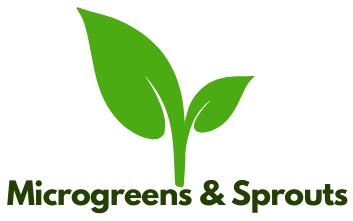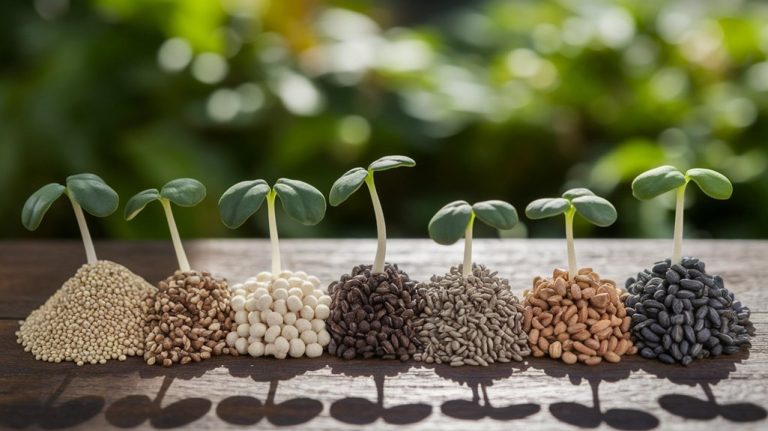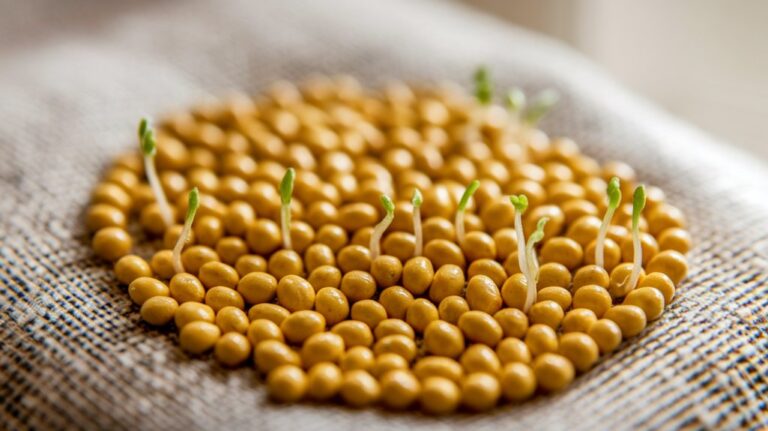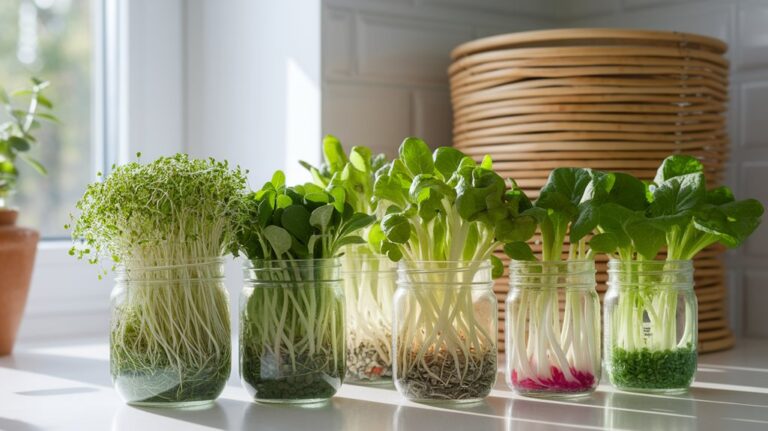How to Preserver the Sprouts After Harvesting
To preserve sprouts after harvesting, I’ve found it crucial to store them in breathable containers, ideally at temperatures between 32°F to 40°F. I rinse them gently, pat them dry, and remove any wilted pieces. Maintaining humidity around 60-70% is key, so I lightly mist when necessary. For longer storage, freezing is effective—just blanch first to keep their crunch. If you notice discoloration or a bad odor, it’s best to discard them for safety. You’ll discover even more helpful strategies!
Key Takeaways
- Rinse sprouts gently under cool water, then pat dry to remove excess moisture before storage.
- Store sprouts in breathable containers to maintain airflow and prevent mold growth.
- Keep the refrigerator temperature between 32°F to 40°F and humidity at 60-70% for optimal preservation.
- Regularly check for signs of spoilage, such as wilting, discoloration, or unpleasant odors, and remove affected sprouts.
- Consider freezing sprouts after blanching to preserve freshness and nutritional value for longer storage.
Understanding the Shelf Life of Sprouts
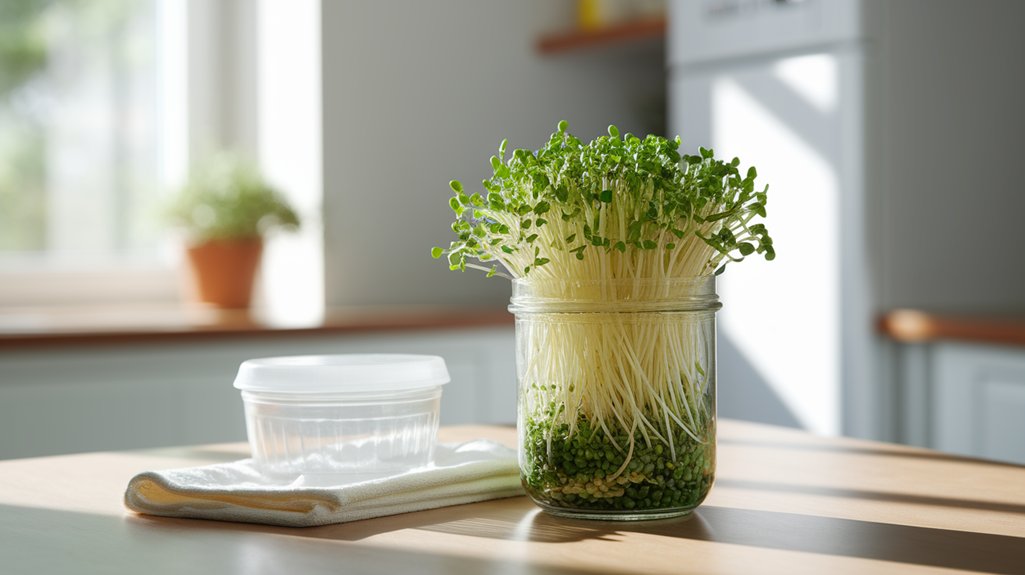
Although sprouts are nutritious and flavorful, their shelf life can be surprisingly short if not managed properly. Typically, I’ve found that most sprouts can last about 3 to 7 days in the refrigerator, depending on the type and initial freshness.
Factors like moisture, temperature, and exposure to light can significantly impact their longevity. For instance, if I notice any signs of wilting or discoloration, I know it’s time to use them quickly.
To maximize their shelf life, I always wash them just before consumption rather than storing them wet. Storing in breathable containers allows for air circulation, which is crucial.
Ideal Storage Conditions for Fresh Sprouts
To keep your fresh sprouts at their best, it’s crucial to monitor the optimal temperature range and humidity levels.
I find that storing them between 32°F and 40°F helps maintain freshness while controlling humidity prevents wilting or spoilage.
Let’s explore effective techniques for achieving these ideal storage conditions.
Optimal Temperature Range
When I store fresh sprouts, I always keep in mind that the optimal temperature range for their preservation is crucial for maintaining freshness and nutrient content.
Ideally, I aim for a temperature between 32°F and 41°F (0°C to 5°C). This range slows down spoilage while preserving the vibrant flavors and textures I love.
Here are some key benefits of maintaining this temperature:
- Enhanced freshness: Keeps sprouts crisp and lively.
- Nutrient retention: Preserves vitamins and minerals.
- Extended shelf life: Reduces waste and maximizes usage.
- Flavor preservation: Maintains that delightful taste.
- Optimal hydration: Keeps sprouts plump and juicy.
Humidity Control Techniques
Maintaining the right humidity levels is just as important as temperature control for preserving fresh sprouts. I’ve found that keeping humidity between 60-70% is ideal to prevent wilting and spoilage.
To achieve this, I often use a hygrometer to monitor levels in storage. If humidity drops, I lightly mist the sprouts with water, ensuring not to soak them, which can promote rot.
Conversely, if humidity is too high, I recommend using a fan or opening storage containers slightly to increase airflow.
Additionally, I always store sprouts in breathable bags or containers that allow moisture regulation.
Preparing Sprouts for Storage

Preparing sprouts for storage involves a few essential steps to maintain their freshness and nutritional value. First, I make sure to rinse the sprouts gently under cool water to remove any debris.
Then, I carefully pat them dry with a clean towel to eliminate excess moisture, which can lead to spoilage.
Next, I sort through the sprouts, discarding any that are wilted or discolored.
After that, I pack them in breathable containers to ensure proper airflow.
Finally, I label the containers with the harvest date to keep track of their freshness.
- Freshness is key for flavor!
- Nutrients are best preserved when handled gently.
- Proper storage prevents waste.
- Enjoying homegrown sprouts feels rewarding.
- Every sprout deserves a chance to shine!
Refrigeration Techniques for Maximum Freshness
To keep your sprouts fresh after harvesting, I focus on maintaining the optimal temperature range in my refrigerator, ideally between 32°F and 40°F.
Additionally, moisture control is crucial; I use breathable containers that prevent excess humidity while allowing some air circulation.
Optimal Temperature Range
When I store freshly harvested sprouts, keeping them at the right temperature is crucial for maintaining their crispness and nutritional value. Ideally, I aim for a temperature range of 32°F to 40°F (0°C to 4°C). This range helps slow down respiration and decay, extending their shelf life significantly.
Here are some key points I consider:
- Freshness enhances the flavor in my dishes.
- Nutritional value is preserved, ensuring a healthy choice.
- Crisp texture makes each bite enjoyable.
- Proper temperature reduces spoilage, minimizing waste.
- It gives me peace of mind knowing I’m maximizing my harvest.
Moisture Control Methods
Although maintaining the right temperature is essential, controlling moisture levels is equally vital for preserving the freshness of my harvested sprouts. High humidity can lead to mold, while low humidity causes wilting. Here’s a practical approach I use:
| Moisture Control Method | Description | Benefits |
|---|---|---|
| Damp Cloth | Wrap sprouts in a damp cloth | Retains moisture without excess |
| Airtight Container | Store in a sealed container | Prevents moisture loss |
| Humidity Pack | Include a humidity pack | Maintains optimal moisture |
| Regular Checks | Inspect sprouts daily | Early detection of spoilage |
| Refrigeration | Store in the fridge at 34°F-38°F | Slows down spoilage |
Implementing these methods helps ensure my sprouts stay fresh longer.
Using Airtight Containers for Sprout Preservation
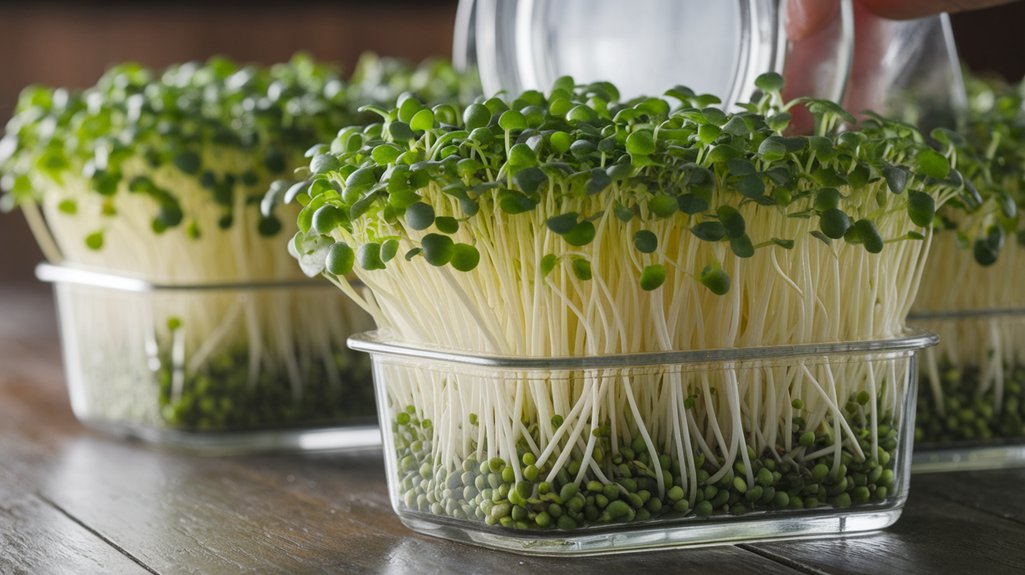
Using airtight containers is one of the most effective ways I’ve found to preserve sprouts after harvesting.
These containers create a sealed environment that helps maintain freshness and nutritional value. Here’s why I love using them:
- They prevent spoilage, ensuring my sprouts stay crisp and vibrant.
- They block out unwanted odors, keeping my fridge smelling fresh.
- They protect against pests, safeguarding my hard work.
- They allow for easy stacking, optimizing my fridge space.
- They make it simple to grab a handful whenever I need a nutritious snack.
The Role of Moisture in Storing Sprouts
When it comes to storing sprouts, managing moisture is crucial for maintaining their freshness.
I’ve found that optimal humidity levels help prevent spoilage and preserve their crunch.
Additionally, selecting the right packaging can enhance moisture retention, ensuring your sprouts stay vibrant and tasty for longer.
Optimal Humidity Levels
Maintaining optimal humidity levels is crucial for preserving the freshness of sprouts post-harvest. Too much moisture can lead to mold, while too little can cause wilting. I’ve found that keeping the humidity around 85-90% is ideal. This range helps maintain crispness and flavor without compromising the sprouts’ integrity.
Here’s what you need to consider:
- Freshness: Sprouts stay vibrant and alive.
- Flavor: Moisture enhances their natural taste.
- Shelf Life: Proper humidity extends storage duration.
- Nutrition: Keeps essential nutrients intact.
- Texture: Prevents limpness, ensuring crunchiness.
Monitoring humidity isn’t just about preservation; it’s about ensuring that every bite of your sprouts remains delightful and satisfying. A little attention to these details can make a big difference in your culinary experience.
Packaging for Moisture Retention
Effective packaging plays a crucial role in moisture retention for sprouts, directly impacting their freshness and longevity. I’ve found that using breathable materials, like perforated plastic bags, helps maintain the right humidity levels without trapping excess moisture.
It’s vital to avoid airtight containers, as they can promote mold growth. Instead, I recommend using containers that allow for some airflow, ensuring that sprouts stay damp but not soggy.
Additionally, including a moisture-absorbing material, like a paper towel, can help regulate excess humidity inside the packaging.
Always store the packaged sprouts in a cool, dark place or the refrigerator to further extend their shelf life. By paying attention to packaging, I can significantly enhance the quality of my harvested sprouts.
Freezing Sprouts: A Long-Term Solution
Freezing sprouts is one of the most effective ways to preserve their freshness and nutritional value long after harvesting.
I’ve found that proper freezing techniques ensure they retain their crunch and vibrant color when you’re ready to use them.
Here’s how I do it:
- Blanching: I briefly boil the sprouts to inactivate enzymes.
- Cooling: I immediately plunge them into ice water to stop cooking.
- Drying: I lay them out on a towel to remove excess moisture.
- Packing: I use airtight bags to prevent freezer burn.
- Labeling: I always mark the date for easy tracking.
Creative Uses for Leftover Sprouts
While I often freeze sprouts to keep them fresh, I also love finding creative ways to use any leftovers. Here are some practical ideas to ensure nothing goes to waste:
| Use Case | Description | Benefits |
|---|---|---|
| Stir-Fry | Toss them in a quick stir-fry with veggies | Adds crunch and nutrition |
| Salad Topping | Use them as a fresh topping on salads | Enhances texture and flavor |
| Smoothies | Blend into smoothies for added nutrients | Boosts health benefits |
These methods not only reduce waste but also enhance your meals. It’s amazing how versatile sprouts can be! So next time you have leftovers, don’t hesitate to get creative and incorporate them into your dishes.
Signs of Spoilage: Knowing When to Discard
Even with creative uses for leftover sprouts, it’s important to know when to discard them to avoid health risks. Spoilage can occur quickly, and I’ve learned to watch for specific signs to ensure safety.
Here are some red flags to look out for:
- Unpleasant, sour odor
- Slimy or wet texture
- Discoloration or dark spots
- Mold growth, especially fuzzy patches
- Wilted or droopy appearance
If I notice any of these signs, I don’t hesitate to toss them. Consuming spoiled sprouts can lead to foodborne illnesses, which nobody wants to deal with.
Tips for Enjoying Sprouts at Their Best
To truly enjoy sprouts at their best, I focus on their freshness and proper preparation.
First, I always rinse the sprouts thoroughly under cold water to remove any dirt or residues. I find that using a salad spinner can effectively dry them, preventing excess moisture that can lead to spoilage.
Next, I prefer to eat them raw in salads or sandwiches to fully appreciate their crunch and nutritional benefits. If I decide to cook them, I lightly steam or sauté them for just a few minutes, preserving their vibrant color and crisp texture.
Lastly, I store any leftovers in an airtight container in the fridge, ensuring they stay fresh for my next meal. Enjoying sprouts this way maximizes their flavor and health benefits.
Frequently Asked Questions
Conclusion
In conclusion, preserving sprouts after harvesting is essential for maintaining their freshness and nutritional value. By understanding their shelf life and following proper storage techniques, like refrigeration and using airtight containers, you can extend their usability. Freezing offers a great long-term solution, while being mindful of spoilage signs ensures you only consume the best. With these tips, you’ll not only enjoy your sprouts at their peak but also reduce waste and enhance your meals.
